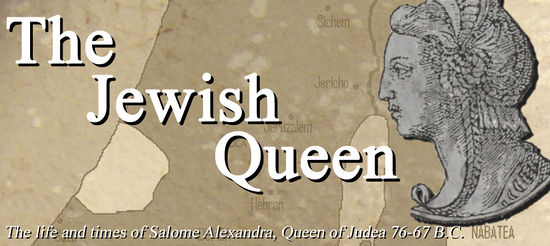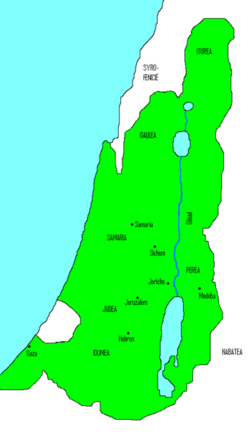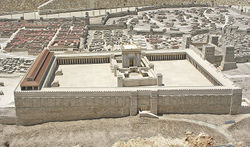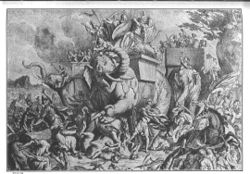Difference between revisions of "Category:Salome Alexandra (subject)"
| Line 103: | Line 103: | ||
[[File:Salome Alexandra Rouille.jpg|thumb|250px|Salome Alexandra (1553), by [[Guillaume Rouille]]]] | [[File:Salome Alexandra Rouille.jpg|thumb|left|250px|Salome Alexandra (1553), by [[Guillaume Rouille]]]] | ||
[[File:Salome Alexandra Street.jpg|thumb|left|250px|Salome Alexandra Street in Jerusalem]] | [[File:Salome Alexandra Street.jpg|thumb|left|250px|Salome Alexandra Street in Jerusalem]] | ||
|} | |} | ||
|} | |} | ||
Revision as of 12:12, 31 January 2016
|
Salome Alexandra -- Overview Salome Alexandra became Judea’s political ruler in 76 B.C.E. upon the death of her husband, Alexander Jannaeus, during the battle of Ragaba. Josephus hints that she actually held some political power during her husband’s twenty-seven year reign. He suggests this when he states that Antipas, the grandfather of Herod the Great, came to political power when “king Alexander and his wife made him general of all Idumea.” Salome Alexandra appointed her eldest son, John Hyrcanus II, as high priest. Her younger son, Aristobulus II, commanded her army. Salome Alexandra’s reign is regarded as the pinnacle of Pharisaic power. Josephus reports that she restored the Pharisaic regulations that her father-in-law, John Hyrcanus, had abolished. She was highly regarded for her piety. Her son, Aristobulus II, opposed her support of the Pharisees, and tried to remove her from power just before her death. Although Josephus claims that she was largely a pawn of the Pharisees, the prosperity of her reign, her military expansion, and her ability to bring peace between opposing religious factions, suggests that she was a strong and competent ruler. Josephus even acknowledges that Salome Alexandra was a wonderful administrator and that her reign was largely peaceful and prosperous. Salome Alexandra ruled during the disintegration of the Seleucid kingdom. Josephus suggests that she spent considerable money doubling the size of Judea’s army, and hired a core of mercenaries. Salome Alexandra conducted two major military campaigns. Both occurred as a result incursions into the region by Tigranes the Great. The first was an expedition against the Iturean Ptolemy, the son of Mennaeus, to prevent him from taking Damascus. Her son Aristobulus II commanded the Judean army. Josephus states that he returned home having accomplished nothing noteworthy. The extant historical sources and numismatic evidence suggest that we do not have a complete understanding of what occurred during this expedition. Tigranes minted coins in Damascus from 72/1 B.C.E. to 70/69 B.C.E. A coin of Cleopatra Selene and her son Antiochus XIII Asiaticus suggest that she held Damascus until 72/1 B.C.E. Prior to this time, the Nabatean king Aretas III occupied the city from 84/3 B.C.E. until 72 B. It is uncertain whether Aretas III or Cleopatra Selene was in possession of Damascus when Aristoublus II arrived. The Qumran text 4QHistorical Text D (4Q332) may contain an allusion to this time. Fragment two of this poorly preserved document contains an enigmatic passage that reads “[to] give him honor among the Arab[s .” This may refer to the campaign of Aristobulus II to Damascus, or perhaps to some unknown treaty Salome Alexandra made with Ptolemy or Aretas III. Line four of this text may refer to negotiations between one or more of these rulers and Salome Alexandra and reads: “with secret counsel Shelamzion came.” Salome Alexandra’s second campaign was in reaction to Tigranes’s invasion of Syria and Judea. He had apparently taken some Jews captive before besieging Cleopatra Selene in Ptolemais. The historical sources report that Salome Alexandra won over Tigranes by treaties and presents while he was attacking the city. Tigranes left the region shortly after capturing Ptolemais. He took Cleopatra Selene prisoner. Although Salome Alexandra may have convinced Tigranes to leave Syria, the sources suggest that an invasion of Armenia by the Roman general Lucullus gave him no option but to curtail his Syrian campaign and not attack Judea. Salome Alexandra’s reign appears to have been peaceful following Tigranes’s departure. She became ill during her final days and tried to ward off a coup by her youngest son. Sometime before her death she appointed Hyrcanus II her successor. She died in 67 BCE, at the age of seventy-three. She ruled Judea for nine years. The Talmud and other Jewish writings contain favorable references to her reign, and consider it a golden age.
Salome Alexandra in literature & the arts The Israeli author, playwright, and politician, Moshe Shamir (1921-2004) includes Salome Alexandra in his 1958 novel The King of Flesh and Blood, which is a fictional account of a portion of Alexander Jannaeus’s reign. The contemporary playwright Lauri Donahue has written a 2003 play focusing on Salome Alexandra titled “Alexandra of Judea.” Popular Culture Following the creation of the modern State of Israel, Jerusalem’s authorities changed the name of Princess Mary Street to Queen Shlomzion Street to honor Salome Alexandra. In 1977, Ariel Sharon, the former Israeli politician, general, and prime minster, named his now-defunct political party, Shlomtzion (“Peace of Zion”).
Salome Alexandra in scholarship
References
Related categories External links
Ancient Sources |
Highlights
 Salome Alexandra (1553), by Guillaume Rouille |
Pages in category "Salome Alexandra (subject)"
The following 11 pages are in this category, out of 11 total.
1
2
- Alexandra of Judea (2003 Donahue), play
- Silencing the Queen (2006 Ilan), book
- Alexandra Salomé: a rainha dos judeus (Salome Alexandra: Queen of the Jews (2011 Portoliveira), novel
- Queen Salome: Jerusalem’s Warrior Monarch of the First Century B.C.E. (2012 Atkinson), book
- Queen of the Jews: Salome Alexandra (2012 Petsonk), novel
- Jerusalem's Queen: A Novel of Salome Alexandra (2018 Hunt), novel
Media in category "Salome Alexandra (subject)"
This category contains only the following file.
- 2012-E Xeravits.jpg 339 × 499; 18 KB





